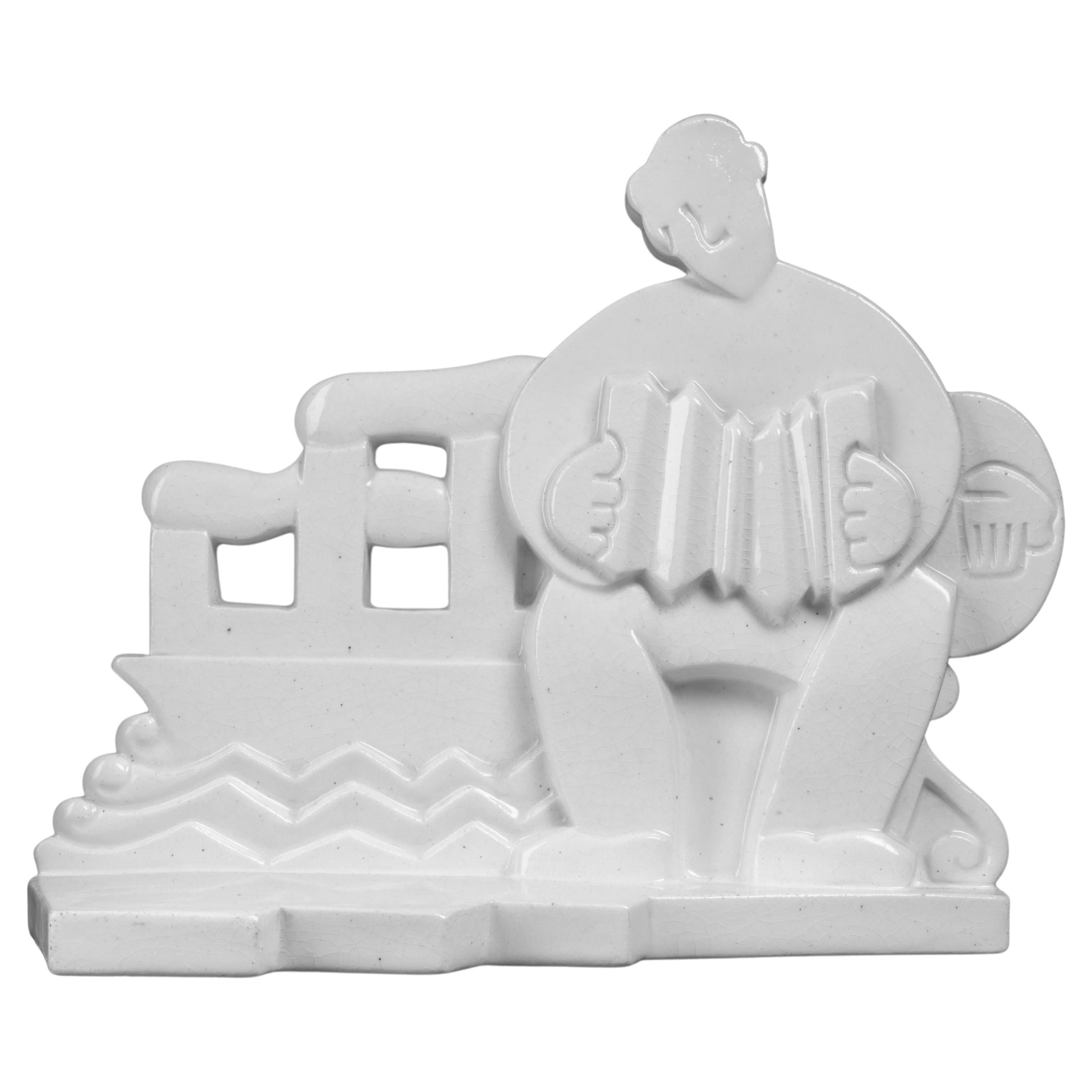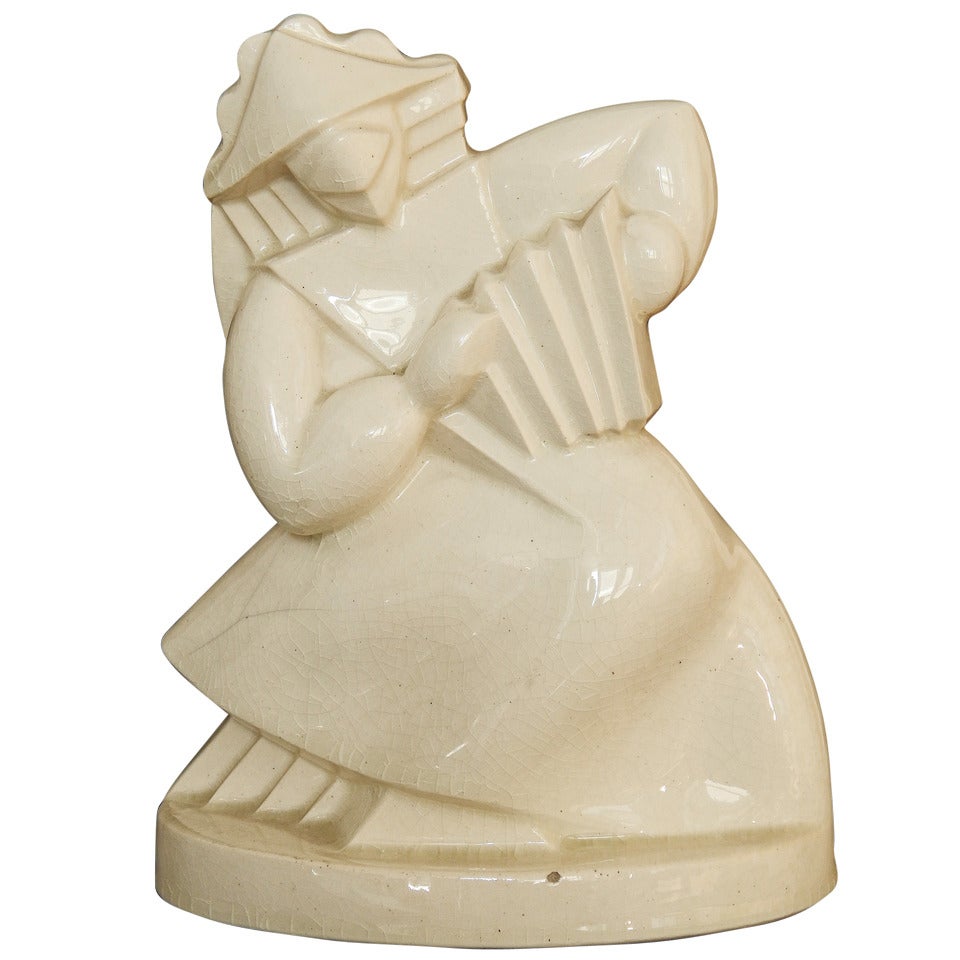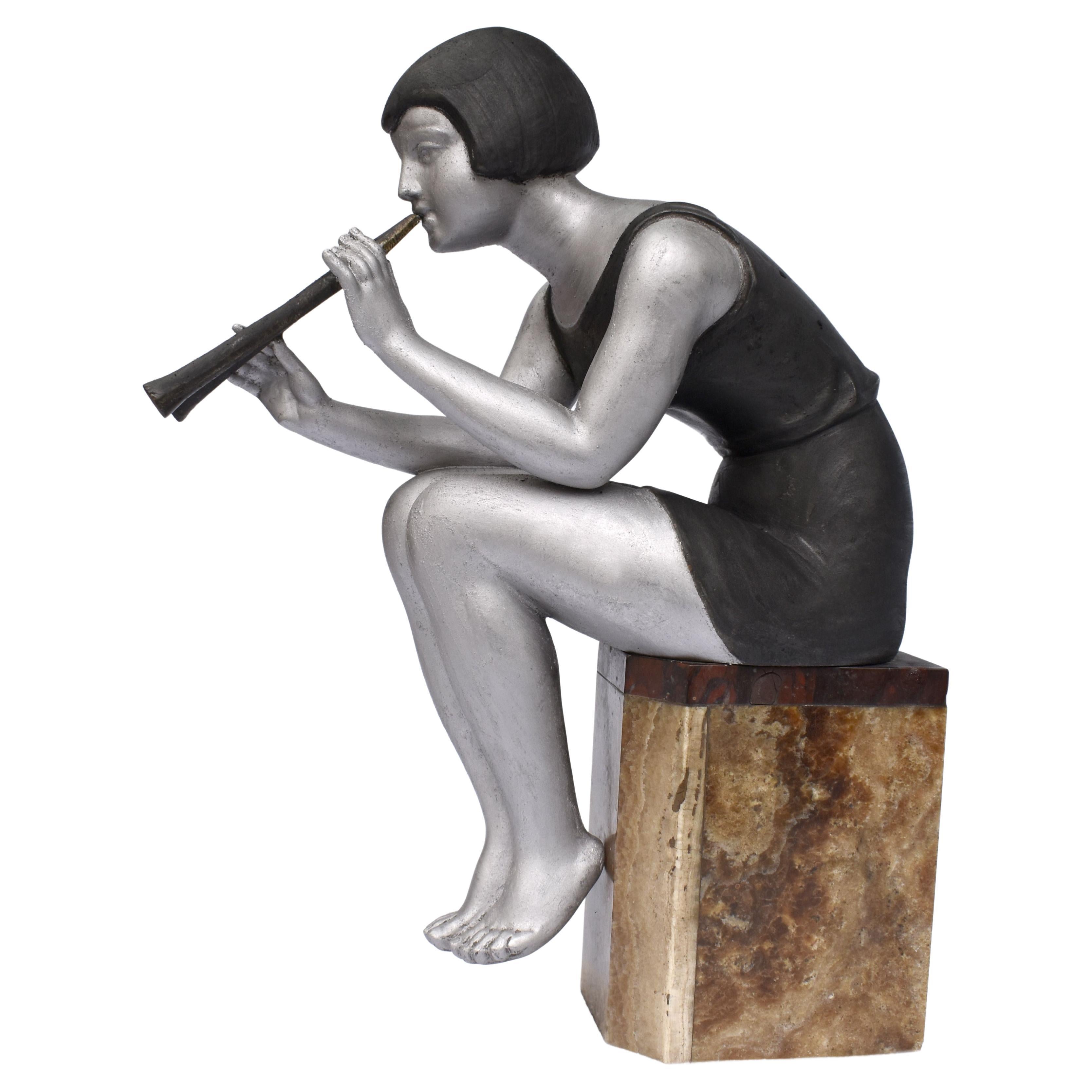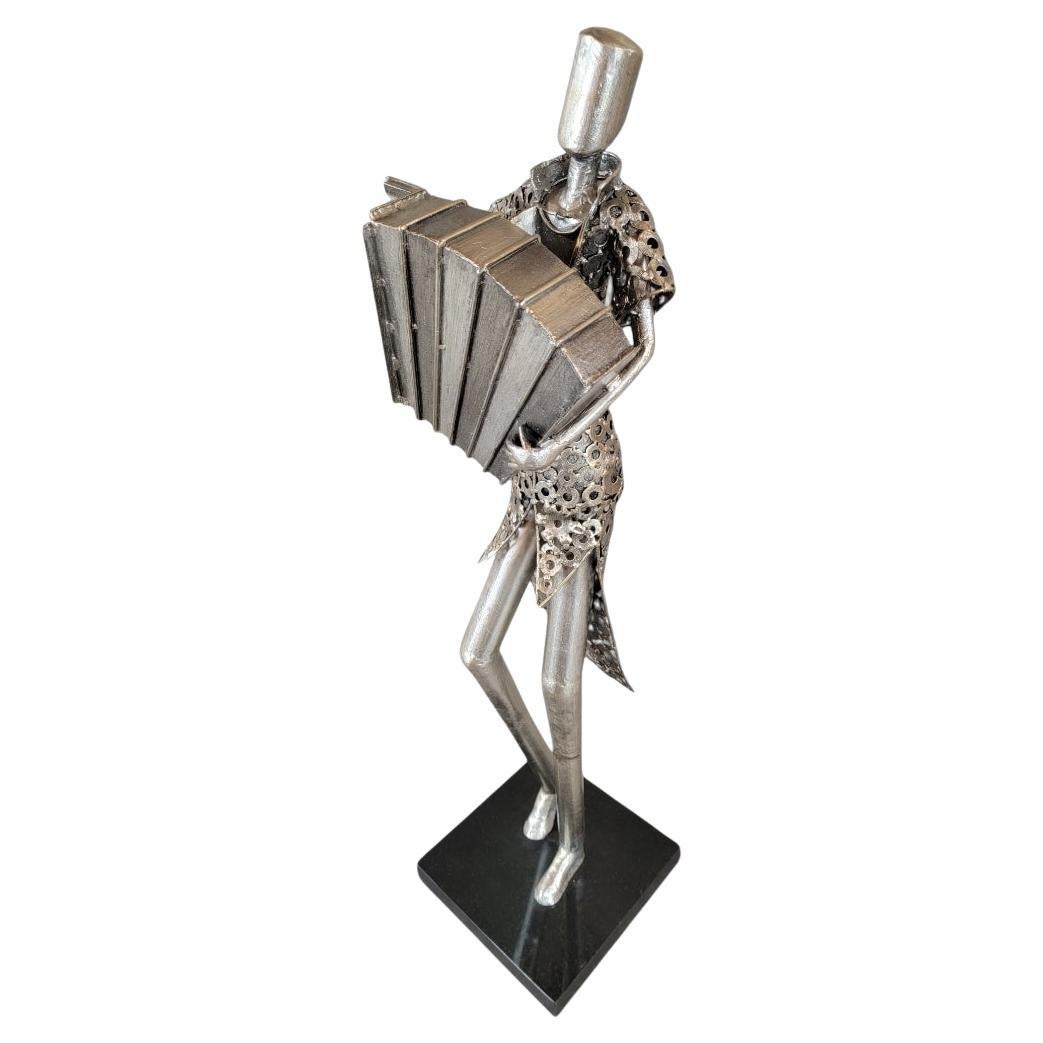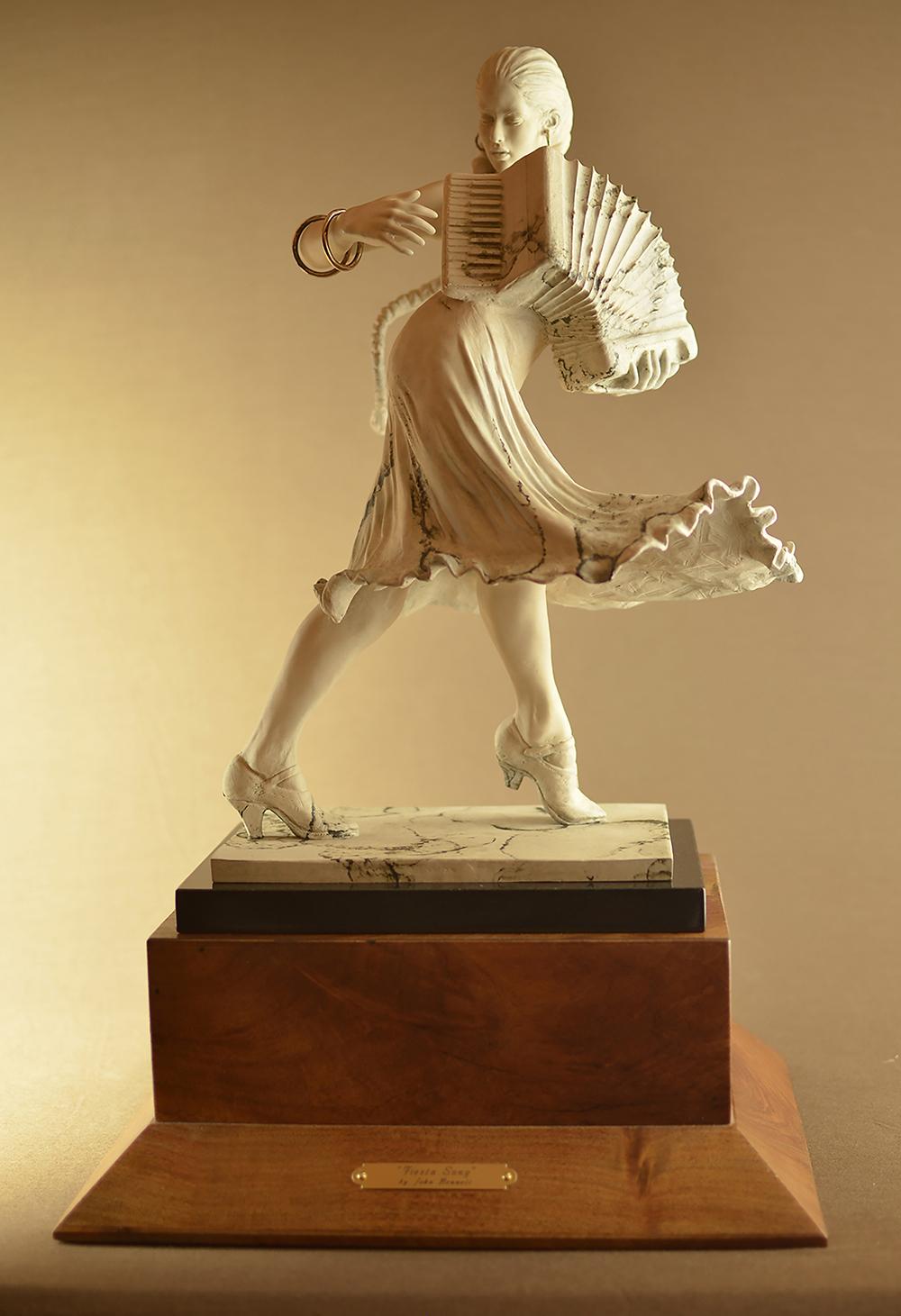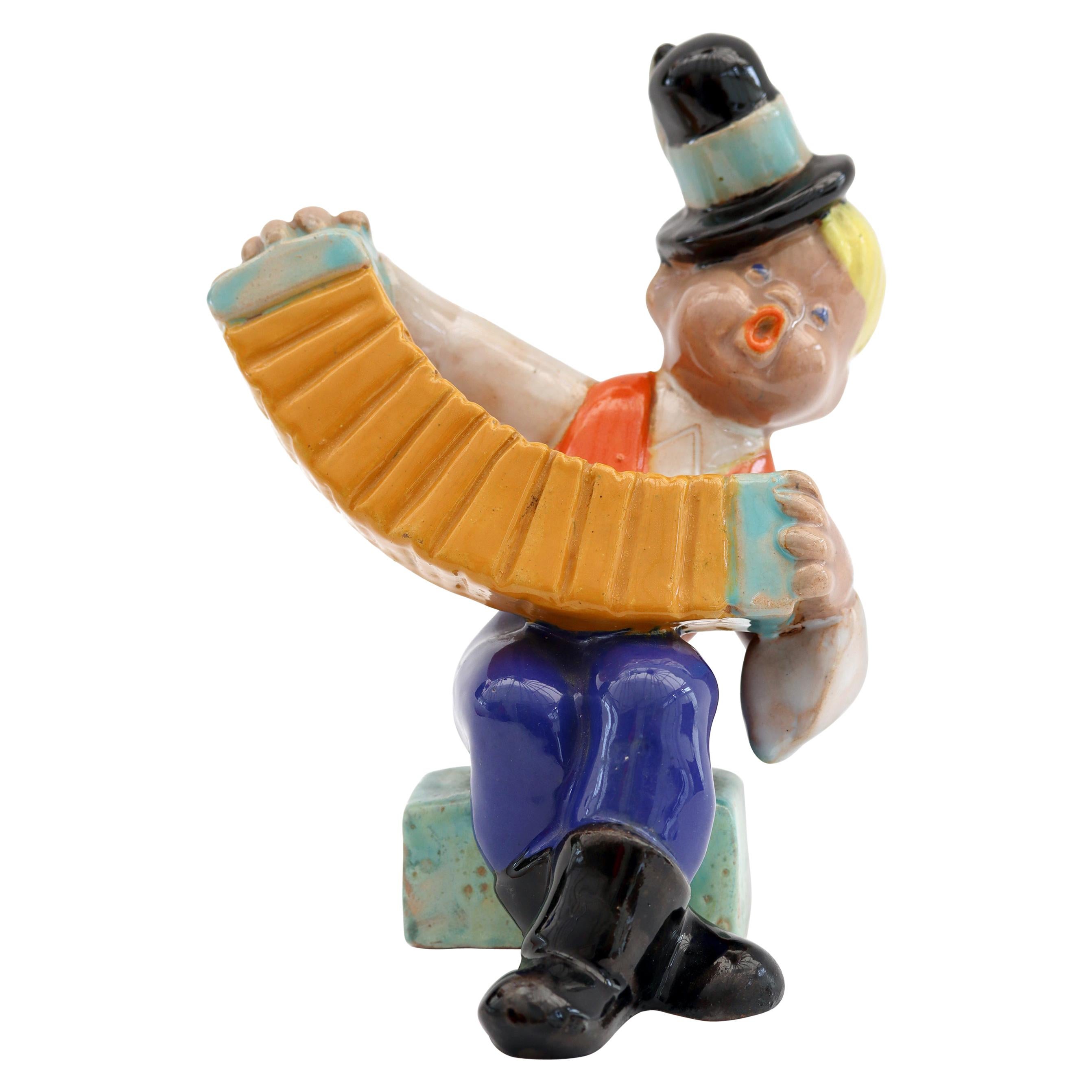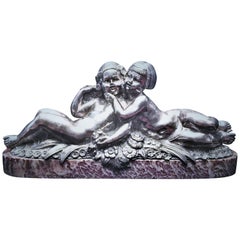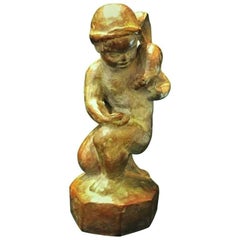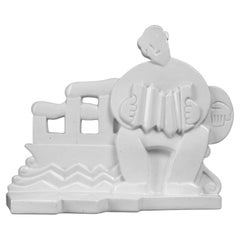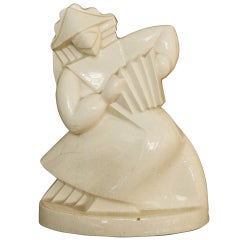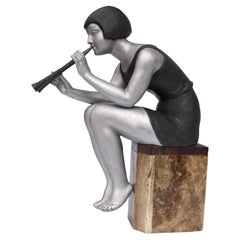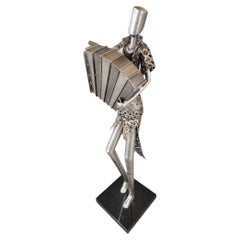Items Similar to Edgardo Simone, Accordion Player, Art Deco Silvered Plaster Sculpture, ca. 1925
Want more images or videos?
Request additional images or videos from the seller
1 of 14
Edgardo Simone, Accordion Player, Art Deco Silvered Plaster Sculpture, ca. 1925
$2,900
£2,215.31
€2,545.17
CA$4,146.38
A$4,568.34
CHF 2,364.85
MX$55,004.01
NOK 29,944.72
SEK 28,131.17
DKK 19,004.56
About the Item
Edgardo Simone, (Italian/American, 1890-1948)
Classically trained in Italy at the Beaux Arts Academy in Rome from 1906 to 1913, Edgardo Simone became a famous sculptor in Italy and the United States using mediums of terracotta, ceramic, bronze, and plaster. He earned a Doctorate of Design and Sculpture at the Academy and then emigrated to the United States where he worked in New York, Chicago and southern California. His style was influenced by Art Nouveau, Art Deco and other modernist influences.
In Italy, he had received three times the Croix de Guerre and was decorated by King Victor Emmanuel II and Queen Margherita. Before moving to America, he had much recognition in Italy. He had created war and city monuments, and tombstones in twenty-six Italian cities. When he arrived in New York City, one of the newspapers carried a headline: "Italy's greatest Sculptor Arrives in New York."
In New York, Simone became prominent in society and did many portrait busts including such of Thomas Edison, John J. Pershing, Henry Ford and Louis Brandeis. Sally Rand, the famous fan dancer of Chicago's World's Fair in 1933-1934, sat as a model in his studio as did President Franklin Roosevelt and author Theodore Dreiser.
In 1940, he married composer Radie Britain (1897-1994) in Arizona, and five years later, she became the first woman to receive the Julliard Publication Award for a composition she dedicated to Charles Lindberg and his historic flight across the ocean to Paris. After marriage, the couple moved to Coronado, California where Simone crafted works for Franciscan missions. In the 1940s, they moved to Los Angeles, and he worked at MGM Studios doing busts of Hollywood celebrities, such as Marlene Dietrich and David Niven. He also created a full-sized depiction of Jesus Christ for an alter scene in the movie, The Song of Bernadette; and a ceramic piece modeled by the wife of illustrator, Howard Christy. Edgardo Simone died in Hollywood in 1948.
- Creator:Edgardo Simone (Sculptor)
- Dimensions:Height: 18.5 in (46.99 cm)Width: 11.5 in (29.21 cm)Depth: 9 in (22.86 cm)
- Style:Art Deco (Of the Period)
- Materials and Techniques:Plaster,Silvered
- Place of Origin:
- Period:
- Date of Manufacture:1925
- Condition:Wear consistent with age and use. We make our best effort to provide a fair and descriptive condition report. Please examine photos attentively, as they are an integral part of the description. Send us a message to request more details or discuss price.
- Seller Location:New York, NY
- Reference Number:1stDibs: LU2819328590882
About the Seller
5.0
Gold Seller
Premium sellers maintaining a 4.3+ rating and 24-hour response times
Established in 1993
1stDibs seller since 2017
86 sales on 1stDibs
Typical response time: 5 hours
- ShippingRetrieving quote...Shipping from: New York, NY
- Return Policy
Authenticity Guarantee
In the unlikely event there’s an issue with an item’s authenticity, contact us within 1 year for a full refund. DetailsMoney-Back Guarantee
If your item is not as described, is damaged in transit, or does not arrive, contact us within 7 days for a full refund. Details24-Hour Cancellation
You have a 24-hour grace period in which to reconsider your purchase, with no questions asked.Vetted Professional Sellers
Our world-class sellers must adhere to strict standards for service and quality, maintaining the integrity of our listings.Price-Match Guarantee
If you find that a seller listed the same item for a lower price elsewhere, we’ll match it.Trusted Global Delivery
Our best-in-class carrier network provides specialized shipping options worldwide, including custom delivery.More From This Seller
View AllIgnacio Gallo, Dancing with Satyr, Spanish Art Deco Silvered Bronze, circa 1920s
By Ignacio Gallo
Located in New York, NY
Ignacio Gallo (Spanish/French, 1850-1935) was a Spanish sculptor, who was active as a sculptor and engraver in Madrid and Paris in the interwar period. His works show animal scenes, ...
Category
Vintage 1920s Spanish Art Deco Figurative Sculptures
Materials
Bronze
Charles Raphaël Peyre, French Art Deco Silvered Bronze Sculptural Group, c. 1925
By Charles Raphaël Peyre
Located in New York, NY
Art Deco silvered bronze sculptural group with two female putti figures reclining together in an embrace, surrounded by flowers and filigree. Sculpture has a beautiful silver finish, and rests on the original rouge marble base. Signed on the right front “Raphael Peyre”; and foundry mark “B.L. Paris” with “Cire Perdue” (lost wax) in an oval cartouche in the back.
The piece is very heavy (51 pounds), crating recommended for shipment.
Charles Raphaël Peyre...
Category
Vintage 1920s French Art Deco Figurative Sculptures
Materials
Bronze
Rudolph Henn, Child Feeding a Squirrel, Art Deco Bronze Sculpture, circa 1920s
By Rudolph Henn
Located in New York, NY
Signed by the artist on the plinth, this desk-size sculpture of a child feeding a squirrel was created by the sculptor mostly known for his depictions of children, Rudolph Henn. In t...
Category
Vintage 1920s American Art Deco Figurative Sculptures
Materials
Bronze
Harlequin, American Cubist Modernist Welded Metal Sculpture, ca. 1970s
Located in New York, NY
About sculpture
This figurative sculpture of a Harlequin standing in a relaxed pose is unusual not only in the choice of materials; but, most importantly, due to the unusual combina...
Category
Vintage 1970s American Brutalist Abstract Sculptures
Materials
Metal
Jenő Kerényi, Magician, Hungarian Art Deco Patinated Bronze Sculpture, 1930s
Located in New York, NY
Signed KEREMYI on the back of the plinth.
Some patina abrasions are noticeable in the back area.
The white Carrera marble base obviously is a later replacement.
Dimensions:
Height 14.75”
Width 11.75”
Depth 7.75”.
Jeno Kerényi...
Category
Vintage 1930s Hungarian Art Deco Figurative Sculptures
Materials
Bronze
Ernst Seger, David and Lion, German Art Deco Patinated Bronze Sculpture, c. 1920
By Ernst Seger
Located in New York, NY
Signed “E. Seger”.
Black patina.
Dimensions
Height: 8 inches (20cm)
Width: 7.5 inches (18.75cm)
Depth: 8.5 inches (21.25cm)
THE BIBLE STORY
Samuel 17:34-36
Originally, Saul would not allow David to fight Goliath (17:33). Saul’s reason was simply that Goliath would be stronger than David. David was young and he did not have the experience to fight such a capable enemy as Goliath. David was likely to die, and his death would benefit nobody.
Often people wrongly imagine that they are acting in faith (in other words, that they are trusting God). Really, they are acting in a foolish manner, as if the danger is not real. They are not trusting in God, but in their own thoughts, hopes and desires.
David’s reply to Saul shows us his attitudes. This reply explains clearly why David had offered to fight Goliath. In other words, it shows how David considered himself able to defeat Goliath.
Like many boys and young men in Israel, David had worked as a shepherd. That is, he looked after sheep. He was responsible to look after those sheep in every way. In particular, he had to protect them from wild animals.
Lions and bears are some of the fiercest large wild animals. They were common in Israel at the time of the Bible. They are much stronger than a man (see for example 1 Kings 13:24 and 2 Kings 2:24). Only the bravest and strongest men were able to kill a lion (Judges 14:5-6; 2 Samuel 23:20). However, David had killed both a lion and a bear. He had killed animals that were stronger than him.
David did not believe that the strongest man would win the fight. David had a close relationship with God; he was trusting God to rescue him (17:37). David was not pretending that there was no danger. However, God’s Holy Spirit was active in David’s life (16:13). By the power of his Holy Spirit, God had given David the faith (trust in God) to fight Goliath. Because David really was trusting God, there was no reason for him to be afraid of Goliath.
THE ARTIST
Ernst Seger (1865 1939), born in Neurode (Nowa Ruda, now Poland), studied sculpturing from 1884 at the Kunstschule in Breslau under Robert Härtel. From 1886 he worked in the Atelier of Christian Behrens, where he created the Eichendorff-Memorial for the Silezian City of Neisse. From 1893 to 1894 Seger stayed in Paris where he worked in the atelier of Auguste Rodin. However, Seger finally chose a ‘Jugenstill’ and a more ‘naturalistic’ or ‘Neuklassizismus’ style. His sculptures, modelled like the Greek antiques, were later greatly admired by the National Socialists.
At the end of 1894 Ernst Seger went back to Berlin, founded his own atelier and created the Kaiser Wilhelm I memorial for the Silesian City of Glatz. In 1897 Seger created the sculpture ‘Jugend’ (‘Youth’), which was displayed at the ‘Große Berliner Kunstausstellung’ in 1898, at the ‘Große Berliner Kunstausstellung’ in 1899, at the ‘Münchener Glaspalast Ausstellung’ in 1899 and at the ‘Münchener Glaspalast Ausstellung’ in 1908. As a sculptor Seger regarded this as his first relevant work, his breakthrough. A copy of the sculpture in bronze, 1.60 metres high, was placed in the ‘Scheitniger Park’ in Breslau (now Wroclaw). In 1898 Segers ‘Diana’, the Roman Goddess of the Hunt, the Moon and Childbirth, was unvealed in Park Szczytnicki, Breslau, Polen (earlier ‘Schneitniger Park’). Until 1945 the sculpture stayed in the Schneitniger Park, Breslau. This part of the park is still called ’Dianagarten’.
After the turn of the century the elegant female dancers and nudes by Seger gained great popularity. In 1905 Ernst Seger created -together with the sculptor Bernhard Sehring- the ‘Bismarck Brunnen’ (‘Bismarck Fountain’) in Breslau. This memorial-fountain (which still exists) represents the allegories ‘Kampf’ and ‘Sieg’ (‘Battle and Victory’). Seger’s ‘Verwundete Amazone’ (‘Wounded Amazon’), displayed at the Grosse Münchner Kunstausstellung in the Glaspalast in 1908, was placed in the garden of the ‘Kaufhauses Wertheim’ in Berlin. In the same year he was appointed as a professor. Seger’s marble sculpture ‘Kypris’, created in 1916, was placed in the Alten Nationalgalerie in Berlin. In 1925 the City of Berlin acquired his sculpture ‘Anbetung’ and placed it at the Johannaplatz. ‘Storchenbrunnen’ (‘Stork-fountain’), was placed in 1931 at the Adolf-Scheidt-Platz in Berlin. In 1935 the American newspaper publisher William Randolph Hearst bought Seger’s sleeping ‘Ganymede’.
During the Third Reich Ernst Seger was commissioned numerous Hitler busts...
Category
Vintage 1920s German Art Deco Figurative Sculptures
Materials
Bronze
You May Also Like
PRIMAVERA "Bandoneonist" Extremely rare Art Deco sculpture in Fine Cracked White
By Primavera
Located in SAINT-OUEN-SUR-SEINE, FR
"Bandoneonist" Extremely rare Art Deco sculpture in fine, slightly cracked white earthenware, Sainte Radegonde factory.
Signed with the Primave...
Category
Early 20th Century Art Deco Figurative Sculptures
Materials
Earthenware
"Chinese Accordianist in Cubist Form, " Art Deco Sculpture by Primavera
By Atelier Primavera au Printemps
Located in Philadelphia, PA
A classic example of Art Deco design heavily influenced by Cubism, this ceramic sculpture depicts a Chinese figure playing an accordian, with the creases of the instrument echoed in ...
Category
Vintage 1930s French Art Deco Sculptures
Materials
Ceramic
$1,520 Sale Price
20% Off
Art Deco Large Spelter Figure, French, c1930
Located in Devon, England
Art Deco sculpture in gilded spelter on a solid marble base 'LA JOUEUSE DE FLUTE'. Originates from France and dates to the 1930's. She's unsigned but very much in the manner of Urian...
Category
Mid-20th Century French Art Deco Figurative Sculptures
Materials
Marble, Spelter
Vintage Metal Art Organ Player Statue On Black Base Figurative Sculpture
Located in Chicago, IL
Vintage Metal Art Organ Player Figurative Sculpture Statue on Black Base
Category
Late 20th Century Unknown Post-Modern Figurative Sculptures
Materials
Metal
"FIESTA SONG" ACCORDION PLAYER BRONZE SCULPTURE
Located in San Antonio, TX
John Bennett
(Born 1952)
Fredericksburg, Texas Artist
Image Size: 19 x 13 x 9
Medium: Bronze Sculpture
"Fiesta Song" Accordion Player
John Bennett (Born 1952)
John Bennett was design...
Category
20th Century Modern Figurative Sculptures
Materials
Bronze
Komlos Hungarian Art Deco Pottery Musician Figure, circa 1930
Located in Bishop's Stortford, Hertfordshire
A charming Art Deco Hungarian hand painted pottery figure of a musician by Komlos and dating from circa 1930. Reminiscent and probably inspired by the Wiener Werkstatte and Goldschei...
Category
Vintage 1930s Hungarian Art Deco Pottery
Materials
Pottery
More Ways To Browse
Used Accordions
Chicago World Fair
Antique Tombstone
Fan Dancer
Thomas Edison
1933 Worlds Fair
Chicago World Fair 1933
Cold Painted Bronze Deco Figure
Marble Relief Sculpture
Medallion Sculpture
Antique Idols
Antique Wood Carved Figures
Bisque France
Bronze Nude Dancer
Cherub Carved Wood Antique
Greek Warriors
Hand Carved Nude
Mid Century Ballerina
